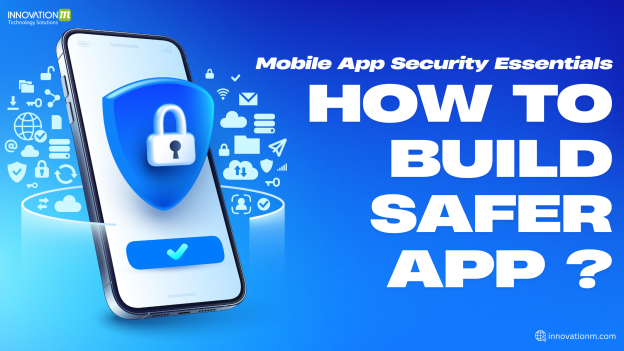Why is it essential?
Mobile apps have become an integral part of our lives. Whether at home, the office, or on vacation, we use mobile apps for binge-watching, tracking our steps, navigation, communication, travel booking, and even finding a doctor.
Mobile applications are being used by government and private organizations for a variety of purposes, including disaster management and employee tracking.
Unknowingly, users share a vast amount of sensitive data, such as location, biometrics, and Social Security Numbers (SSNs), which can put their data at risk and lead to identity theft, financial fraud, and other serious consequences.
A data breach can result in significant loss for businesses and individuals.
Ensuring Data Security: A Mobile App Development Company’s Responsibility
If security is not considered a priority during app development, businesses may face serious consequences that will be difficult to recover from. The risks would include:
- Loss of Customer Trust
- Legal penalties and lawsuits
- Brand damage
- Operational downtime
- Competitive disadvantage
Whether you’re developing an app in fintech, healthcare, logistics, or eCommerce, protecting user data isn’t just about ticking a compliance box—it’s about safeguarding your business reputation.
As mobile threats become more sophisticated, relying on basic encryption and authentication is no longer enough.
Regulatory Compliances that we must consider
You may be required to comply with certain data protection regulations based on the type of application you have, and the location of your users.
- GDPR: The General Data Protection Regulation (GDPR) is a legal framework that sets guidelines for the collection and processing of personal information from individuals who live in and outside of the European Union (EU)
- HIPAA: HIPAA sets the standard for protecting sensitive patient data. Companies dealing with protected health information (PHI) must implement physical, network, and process security measures to ensure HIPAA compliance.
- CCPA: The California Consumer Privacy Act (CCPA), enacted in 2020, protects Californian consumers’ privacy rights regarding their personal information.
- DPDP (India): The DPDP Act is India’s first data protection act, and it establishes a framework for the processing of personal data in India.
- ISO/IEC 27001:27002: An international standard for implementing an effective information security management system (ISMS).
- PCI DSS: PCI DSS is a set of policies and procedures that enhance the security of card transactions and protect cardholders against personal information misuse.
Security Frameworks to Guide Development
To help teams build secure apps, several established frameworks and guidelines are widely followed:
Some of most common mobile security standards
- OWASP Mobile Top 10: OWASP consists of a list of the 10 most critical mobile application security risks, along with effective processes, procedures, and controls to mitigate them.
- iOXT: The ioXt Alliance is a global standard for IoT security. It comprises manufacturers, industry alliances, and government organizations. These members work together to create testable standards and harmonize security best practices. This gives consumers and retailers confidence in the products of an interconnected world.
- NIAP: NIAP is an IT security program to ensure that the government apps align with the security standards set forth by the US government and focus on end-customer needs.
- CWE: CWE provides a list of some of the most common application security vulnerabilities. CWE enables dev teams to understand the possible security threats and select the best tools and services for their application.
- CVSS: CVSS is a universal open and standardized method for rating IT vulnerabilities and determining the urgency of response. This CVSS value, which ranges from zero to 10, helps security analysts prioritize risk as they look to identify and fix vulnerabilities.
- NIST Cybersecurity Framework: Offers structured guidance on identifying and managing cybersecurity risks.
- CIS Benchmarks: Provide detailed, vendor-agnostic security configuration guidelines for mobile OSs.
Adhering to these guidelines not only strengthens your app’s security but also streamlines the audit process and ensures compliance with industry standards.
Best Practices for Mobile App Security
Security must be considered at every phase of your app lifecycle—from planning and coding to deployment and updates. Here’s what that looks like in practice:
- Sensitive Data Encryption
Use strong encryption for data at rest and in transit. Avoid storing confidential data locally if it’s not absolutely necessary.
- Harden Your APIs
Ensure only authorized users can access APIs. Use tokens, rate limiting, and input validation to prevent misuse.
- Avoid Hardcoded Secrets
Never hardcode API keys, credentials, or tokens in your codebase. Use secure key vaults or environment configuration systems.
- Secure Authentication Mechanisms
Implement modern auth standards like OAuth 2.0 and support biometric logins with fallback PINs or passwords.
- Detect Jailbreak/Root Access
Prevent your app from running on compromised devices where system protections are disabled.
- Use Code Obfuscation
Make it harder for attackers to decompile or reverse-engineer your code by obfuscating critical parts.
- Perform Security Testing
Run regular code scans (static analysis), runtime testing (dynamic analysis), and penetration testing before each release.
- Use Trusted SDKs & Libraries
Only integrate SDKs from reputable sources and keep them updated to avoid inherited vulnerabilities.
End Note:
As hackers’ methods grow increasingly sophisticated, companies must bolster their security measures in response. With the rise of AI, machine learning, and cloud sharing, applications have become remarkably intelligent and scalable. However, an app’s success ultimately hinges on its ability to deliver a fast and convenient user experience without compromising user data.
 End to End Technology Solutions
End to End Technology Solutions
